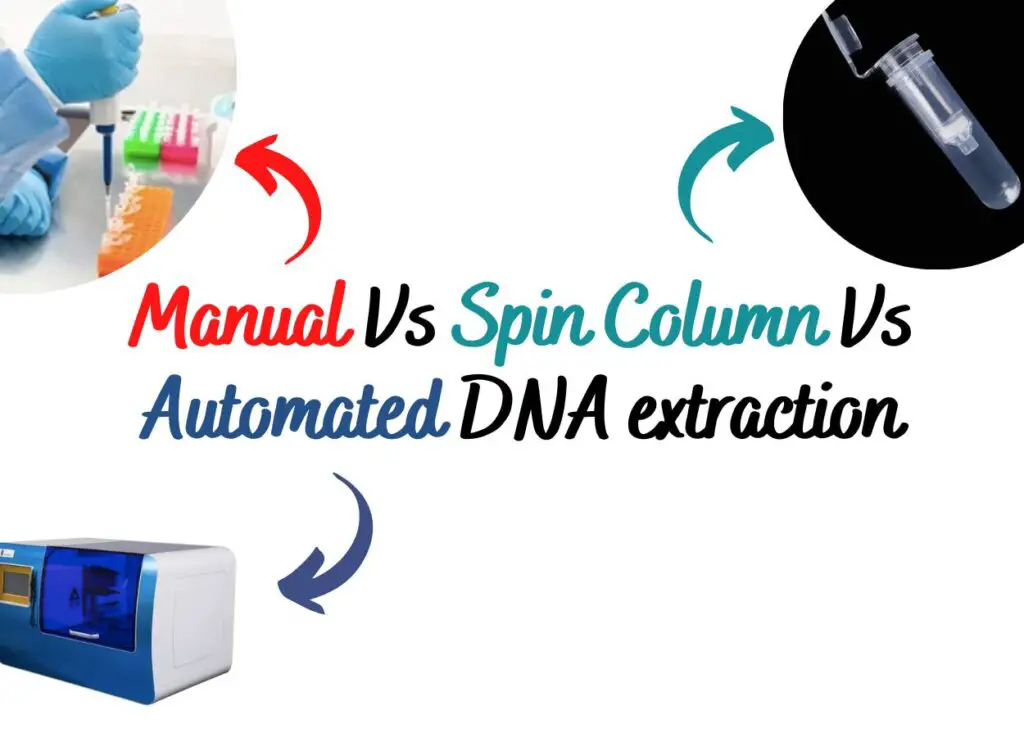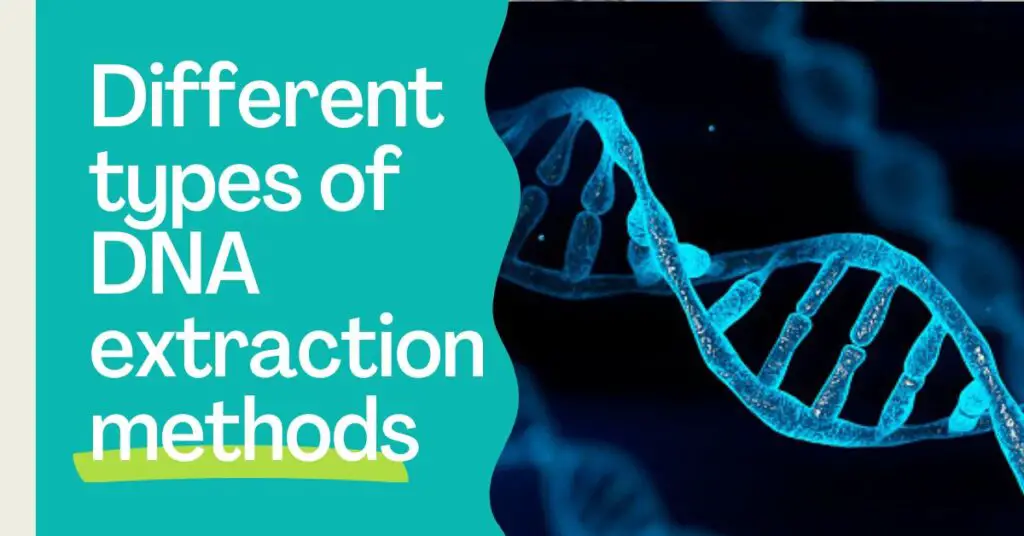“Manual DNA extraction relies on chemical preparation, column-based DNA extraction uses a spin column which is more effective while automated DNA extraction does the job automatically. Let’s check how these three DNA extraction modules are different.”
DNA isolation is an utmost priority in any genetic research or experimentation scheme. A good extract is a key to success in any DNA testing. High yield and excellent purity would be the ultimate goal for any DNA extraction scheme.
DNA testing technology gained more exposure in recent times and thus new technologies are added every day. Spin column kits and automated extraction units are the two most popular advancements.
Where spin-column-based extraction technologies are new-age and state-of-art; an automated extraction system is totally a futuristic approach to the process. The updation from manual to spin column and spin column to automated nucleic acid extraction has many benefits.
However, each technology has its own limitations too. This article compares three of the popular DNA extraction methods– Manual, column-based and automated; discusses the advantages and limitations of each comprehensively.
The objective of this discussion is to educate students about each technology. The final conclusion will help them to understand as well as choose the best technique for their endeavor.
Stay tuned.
If you would like to learn DNA extraction, electrophoresis and PCR, you can download our ebook: From DNA extraction to PCR.
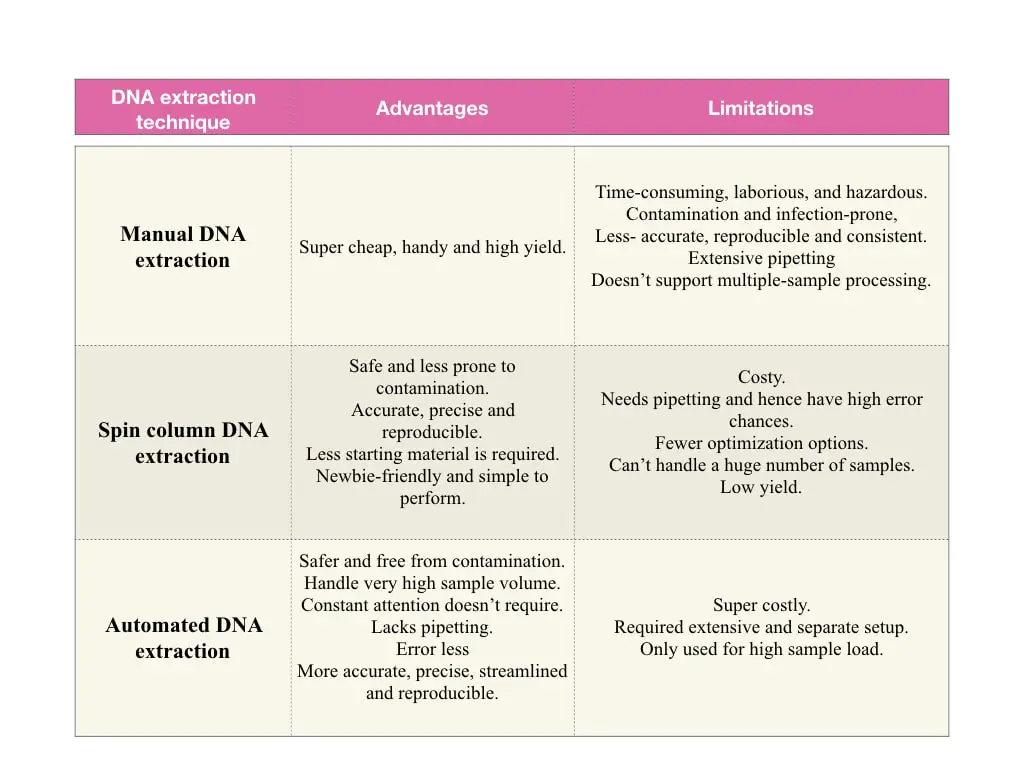
Let us start with a quick introduction.
Key Topics:
What is a Manual DNA extraction method?
Traditional chemical or liquid-liquid-based DNA or nucleic acid techniques are categorized into manual methods. These methods require chemical and solution preparation and extensive sample processing.
Under the treatment of various chemicals and solvents, the nucleic acid (DNA) gets extracted in a sequential manner. Notedly, extensive centrifugation is required. Common Manual DNA extraction methods are
- Salting out techniques
- Phenol:chloroform: isoamyl alcohol
- Conventional Proteinase K-based technique
- CTAB DNA extraction method
The advantages and limitations of each technique are separately discussed in their respective articles. Broadly, manual methods are time-consuming, error-prone and thus not so reliable. However, to get a high yield, PCI and CATB techniques are recommended by experts.

What is Spin column DNA extraction?
Column-based extraction approach technically falls into solid phase extraction. DNA is extracted on a solid phase, like silica. It lacks extensive chemical preparation and completes the process in a few steps.
In principle, a lysis buffer lyses the sample, and DNA is adsorbed on the silica column, and eluted by using a high pH elution buffer. You can read more about it in our previous article: Advantages and Limitations of Spin-column DNA extraction.
Column-based extraction is a super easy, fast and reliable method in comparison to conventional techniques. Customized kits are available for different sample types.
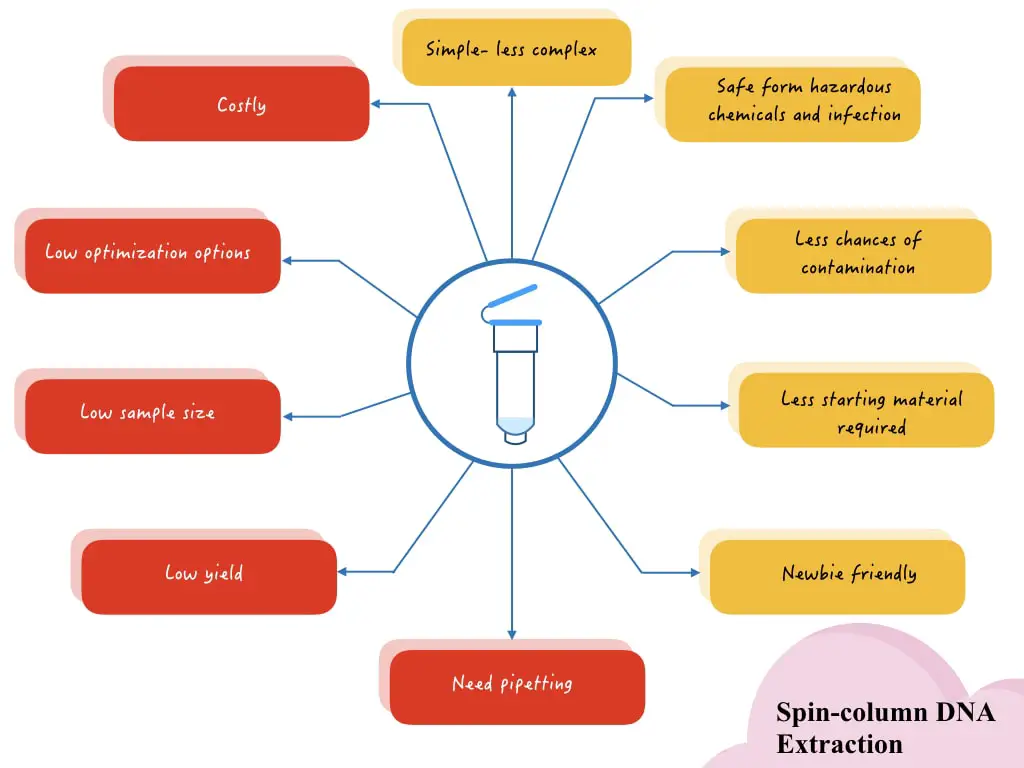
What is Automated DNA extraction?
Put simply, A robot performs extraction in an automated system and hence is more streamlined and reliable. All steps of extraction including adding chemicals to heating and doing incubation to test samples are performed by a robot in a system or machine.
Once we load samples, we do not care about it. Extraction occurs automatically. It’s super costly but at the same time handles so many samples and extracts nucleic acid automatically or without human interference.
Automated extraction systems have great precision, accuracy and reproducibility.
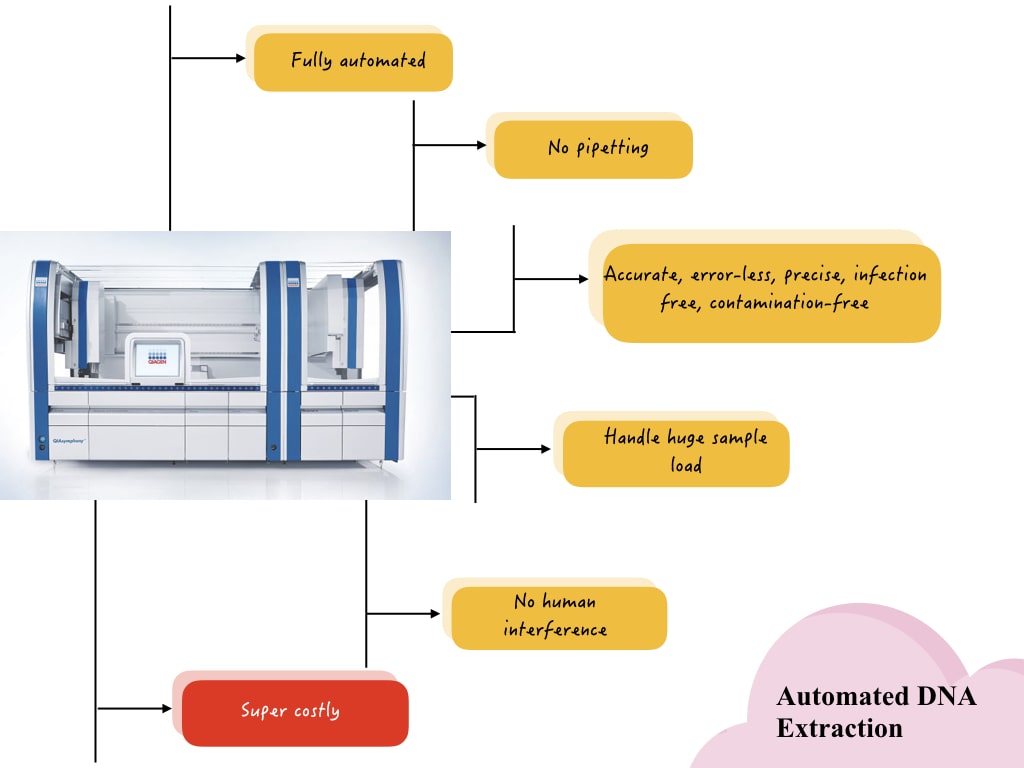
Take a look at the quick comparison.
| Manual | Spin column | Automated | |
| Time | Time-consuming | Fast | Faster |
| Steps | Lysis, separation, precipitation and dilution. | Lysis, binding, washing and elution | Lysis, processing and collection |
| Pipetting | Extensive Pipetting | Less Pipetting | No pipetting |
| Chances of human error | Very high | Comparatively low | Negligible |
| Multiple sampling | No | No | Yes |
| Close monitoring | Extensively required | Required | Not required |
| Sample strength | 1- 10 samples at a time | 10 to 15 samples | 96 samples in a run |
| Error rate | High | Moderate | Negligible |
| Accuracy | Low | Moderate | High |
| Consistency | Low | High | Very high |
| Reliability | Low | High | Very High |
| Reproducibility | Poor | Excellent | Excellent |
Manual vs Column-based vs Automated Extraction:
Now let’s comprehensively compare each method.
Prerequisites
Manual DNA extraction schemes require extensive pre-preparation for the chemical formulation, solution preparation and protocol setup for the sample type. Spin-column kits come up exclusively with almost, “no pre-preparation.”
Above both, the automated technique doesn’t require any pre-preparation, literally Zero preparation. Note that the lab personnel needs to fill each chemical cartridge before sample processing.
Winner- Automated extraction
Extraction steps
Common steps, every manual method has, are lysis of cell wall and nuclear envelope, separation of nucleic acid, precipitation of DNA, nucleic acid washing and dilution of DNA.
Steps in column-based extraction are lysis using buffer, binding of DNA with the solid phase, washing DNA and elution. Notedly, we do not have to perform any of these extensive steps in an automated system, as every step is performed automatically.
Although, it’s notable that the steps of column-based extraction kits are less complex; hence the process is easy and fast to perform.
Winner- automated and spin column kit extraction.
Pipetting and processing
As the manual methods need extensive prerequisites, it needs an ample amount of pipetting, processing and incubation steps. While the spin column kits require comparatively fewer pipetting and processing steps.
But above both, automated extraction doesn’t need any pipetting or processing steps, everything occurs by an automated robot. So it overcomes one of the important limitations of any extraction procedure— chances of human errors. Take a look at the next point.
Human errors
Manual methods are highly error-prone, and spin column extraction has a comparatively low human error rate, as fewer steps are involved. But an automated system of extraction doesn’t have any human error chances. We do not have to process anything here.
Winner- Automated DNA extraction.
Multiple sampling and sample strength
Now coming on to the important part of this comparison, how many samples with how much precision, each technique can handle? Before the discussion, keep in note that the automated system is an advanced version of manual methods.
It’s nothing fancy; just automation!
Meaning, it’s a robotic liquid handling technology that uses robots not humans for sample processing and that is designed to process a large number of samples in a simple run.
The manual method can’t handle multiple samples effectively. As the number of samples increases, the error rate also increases. Nonetheless, the sample strength is a maximum of 10 samples on a single hand.
On the other side, spin column kits can handle multiple samples with substantial precision and accuracy, compared to the manual methods. An expert can handle up to 20 samples on a single hand. Nonetheless, as it does include pipetting steps, an increment in sample size reduces the quality of output, here too.
On top of both, automated extraction can handle multiple samples effectively. It can handle up to 96 samples in a single run without compromising accuracy and precision.
Winner- automated DNA extraction.
Monitoring and attention
Prior experience, expertise and exposure to various samples is required to perform manual extraction. And in addition, constant monitoring is also needed during the entire experiment. Contrary, for spin-column kits, no prior knowledge is required. However, constant monitoring to some extent is still required.
In the first place, no expertise, experience and monitoring is needed for automated extraction. Anyone can put samples in the machine, and the machine runs samples using a pre-installed protocol. Put samples, start the run and you can do the rest of your work.
Winner- Automated DNA extraction.
Error rate and accuracy
As an exclusive human hand is involved in the manual type of isolation, it’s error-prone, as aforementioned. And therefore, has lower accuracy. Contrary, the person has to do nothing more in the column-based kit which makes it more accurate.
However, as it needs a moderate level of pipetting and sampling, errors may occur which compromises the overall accuracy of the extraction. Robotic arms govern the automated extraction system and therefore it is accurate and precise, compared to both.
Winner- automated extraction
Consistency
Both manual and spin column extraction schemes are less consistent while the automated extraction scheme gives consistent results once the protocol is set up. Note: consistency doesn’t mean that we will get the same quality and yield of DNA. It means consistently getting results.
Safety
Manual schemes of nucleic acid isolation compromise safety and have the highest chances of lab personnel getting an infection because the entire process completes in the lab environment and by human efforts only. So safety is the biggest concern in manual methods.
Furthermore, the use of hazardous chemicals like phenol, and chloroform are health hazards too. The spin column doesn’t need any hazardous chemicals; extraction occurs in a closed-column system so is comparatively safer.
But it still has a chance of spreading infection while handling infectious samples like H1N1 or TB. The automated extraction occurs in the closed system, without human interference, therefore, is the safest approach for any nucleic acid extraction experiment.
Winner: Automated extraction.
Contamination
Manual methods are more prone to contamination. Column techniques have lesser contamination chances but may contaminate samples if not processed precisely. For automated methods of extraction, as the entire extraction process completes in a human disturbance-free closed environment, it is free from any contamination.
Conclusively, you and your sample will remain safe in automated DNA extraction. Spin-column doesn’t compromise the safety and chances of contamination, much.
Cost
The Cost of the experiment is the only limitation of automated DNA extraction. Manual methods are super cheap and affordable; kits are comparatively costlier but affordable by research organizations and diagnostic centers. The automated extraction systems, on the contrary, are super costly.
The machine, reagents, cartridge and other parts of the systems are so costly and hence the overall cost of sample processing is so high. However, as it’s faster and more robotic, to process a large number of samples, it’s required.
Strength is the weakness too
Automated NA extraction systems process a large number of samples, in high-speed robotic processing which is also its limitation. For less sample load, it’s useless, literally. It increases the cost as the number of samples decreases.
For processing a few samples in a day for some crucial experiments, the spin column technique is a great option while for students and research scholars, manual methods are strongly advisable.
I know many laboratories that purchased high-cost and high-end extractors during the covid outbreak and that machines are now useless as there is less sample volume now.
Summary
| Advantages | Limitations | |
| Manual DNA extraction methods | Super cheap, handy and high yield. | Time-consuming, laborious, and hazardous. Contamination and infection-prone, Less- accurate, reproducible and consistent. Extensive pipetting Doesn’t support multiple-sample processing. |
| Spin column DNA extraction methods | Safe and less prone to contamination. Accurate, precise and reproducible. Less starting material is required. Newbie-friendly and simple to perform. | Costy. Needs pipetting and hence have high error chances. Fewer optimization options. Can’t handle a huge number of samples. Low yield. |
| The automated DNA extraction system | is Safer and free from contamination. Handle very high sample volume. Constant attention isn’t required. Lacks pipetting. Error lessMore accurate, precise, streamlined and reproducible. | Super costly. Required extensive and separate setup. Only used for high sample load. |
Wrapping up
Our purpose for the present discussion is to see which technique is for who?
Clearly, manual methods are only recommended for college or university-level research and for research students only. They learn many things from it. While small labs, which have a decent sample volume can use spin column kits.
Column-based kits are great options for them as they streamline the process, save time, and improve overall- productivity, accuracy and precision. On the very extreme side, automated extraction setups are only recommended for giant corporations, huge laboratories and diagnostic setups having such a high sample load.
Automation saves time and increases speed, precision and accuracy without human interference. However, if you or your organization have an automated extraction system and not the sample load, you still can’t afford it.
So it’s now clear.
Students have to use manual methods, small labs and professionals can use column-based kits while only huge organizations and labs with high sample inflow can use automated NA extraction systems.
